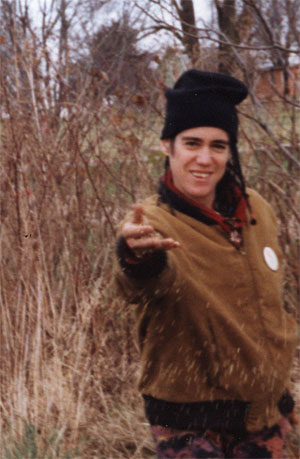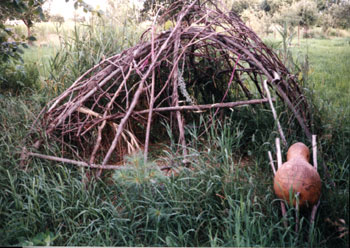|
|
In permaculture, one maps out one's land in terms of Zones, designing it according to distance, usage of the plants, tending requirements, etc. You'd plant your culinary herbs in Zone 1, for example, just outside the door or even on the windowsill. The vegetable garden might be in Zone 2, animals in Zone 3, nurseries or orchards in Zone 4 , & Zone 5 would be the woods. You won't find Zone 0 in many permaculture books, but I understand it as the self, located somewhere in or near the body, & it is the Zone that most concerns me personally. Through learning about diet, nutrirtion, yoga, I keep coming upon principle for tending Zone 0 that parallel basic principles of permaculture. The consistency of the parallel doesn't surprise me, since we humans are as much "nature" as rutabagas, cilantro, or hedgehogs.
 |
Elizabeth planting prairie seed in the Dreamtime gardens. |
THE PROBLEM IS THE SOLUTION: Students of all forms of natural healing learn about the "healing crisis", the often difficult time a person goes through when who chooses to heal him or herself naturally. Symptoms of the original problem commonly recur or even worsen, as the body does its job of dispelling toxins, or chasing the "ghosts of memory" from old wounds. It takes a great "leap of faith" at first to convince oneself that such symptoms are actually welcome positive manifestations of the fact that the body is healing itself. In The Way of Herbs, Michael Tierra goes so far as to say "We put ourselves in situations that cause illness, & thus create our own sicknesses, for several reasons: 1. to grow & learn; 2. to help foster compassion inourselves & others; 3. to repay old "karmic" debts that we may be carrying; 4. to provide an excuse for death to occur (not to mention rest-EW); 5. to get love & attention. The ailment informs us of our resistance & of our imbalance and it provides a focal point for discovering all of the negative energies we have cultivated. In the healing process...the body is brought naturally back to a reflection of total balance."
In yoga, we try to change our mindset through our inner language: we think not of "pain" but of "opening". Where this was at first a contrived notion to me, now (3 years later) it comes naturally. I actually enjoy great bliss doing poses thatt others look at & say, "you must be a masochist to do that". I go right into the place that is opening, a place that I no longer think of as a "problem" - & with breath & intention I stoke it with heat, nurse it with white light, sing "hi-eee!" & watch knots inside of me melt.
Another way to see the problem as the solution in the body is to change our think about that part of us we consider our biggest "problem". My lower intestines are the first part to give me grief. But another angle on it is that my body has in a sense chosen this part as the best vehicle for getting rid of toxins. Perhaps it's taxed because it's the best part for the job & has alot of work to do. Maybe I should be grateful to my intestines for helping me to stay healthy, rather than throw bad vibes at them, shaking my fingers in my mind everytime they "act up". This subtle yet huge mental shift has so far proven itself beneficial to me.
GROW SOIL: Much as the earth can only continue growing if we heal it by replenishing its topsoil & replanting its forests, so too must we refurbish our bodies so they can make use of the food we eat & the air we breathe, as well as protect against toxins & heal itself. In parallel with the depletion of the plant topsoil, "modern medicine" & overprocessed "empty" foods have depleted our immune systems. We have not only have a hard time avoiding illness, but without complete intestinal flora, we are unable to effectively break down the food we do eat into its most useful sorms. (Our digestive system & the food we ingest have a relationship similar to that the worms & micro-organisms in the soil & mychorriza of the plant's roots, have the nutrients in the soil.)
Other groundwork we must build for ourselves is a constant daily awareness of our posture & breathing, a perpetual yoga. Yoga isn't just something one does for an hour at a time; a "session" is helpful, but not if when it's over one goes back to slumping in a chair, or stressing out.
We need to grow a healthy mindset about our bodies so we become victims or captives of them.
EVERYTHING GARDENS: Probably our favorite permaculture principle here at Dreamtime, especially as it makes a noun into a verb.* Growing plants isn't confined just to shovels & our rows of vegetables; it's a way of being, a lifestyle, an attitude, a mindset. Through it we encourage an ecological system in which we & the butterflies are as much a part of it as the plants, the sculptures, the manure tea, & the paths we squat on. Increasing evidence shows that the very shape & placement of a garden as well has great impact on the health of the garden. Our bodies are ecosystems too, health a state of balanced being in which every aspect is interrelated. The whole body & self must become involved in health & healing alike, or rather, they already are involved: we must understand that from the inside out.
 |
Woman's menstrual hut in the apple orchards. |
I've learned to heal intestinal problems through breathing exercises; in my yoga classes I've seen back problems disappear when the ham strings loosen. And I've seen backs remain crooked when students don't stretch all the way thruwith their fingertips, toes, bellies, & breath.
Change towards a better diet may be a matter of adding more foods, rather than, as many health-conciouspeople nowadays think, eliminating more & more. In the Ayurvedic approach to cooking one tries to encompass all the universal elements into one meal via inclusion of all six tastes. Picture an Indian dish with all its abundance of colors, textures, spices, & aromas: it seems to fit the phrase "Everything Gardens".
*I also like to use the new verb "yog", much preferred to "doing yoga" which sounds too much like "doing drugs" or "doing the dishes". Yoga isn't a thing, it's an activity, a whole being activity.
LOW INPUT, HIGH YIELD: Although there's no doubt that good health & good gardening both require work, the quality over quantity rule also applies. In permaculture, you work with the land to let the earth do the work in its own way. The body, too does best to heal itself with a minimum of interference. The get-better-quick approach of both modern medicine & modern agriculture merely erases symptoms, not only bypassing the cause of the imbalance but creating further imbalance by killing off the beneficial micro-organisms along with the unwanted ones.
I find that doing asanas (poses) very intensively with the quick shallow "stoker breath" for a short period of time each is far more effective than trying to quietly hold each pose for several minutes with long slow breaths. This either bores some students or they hurt themselves or they never gain the kind of willful & proactive stance needed to break through old hurts & blockages.
Many new-age suggestions about healing - that we should eliminate more foods & substances or change our diet entirely, devote more time to retreats, fasting, colonics, megavitamins, or what have you are to me perhaps unnecessarily high input approaches. Most of us are too busy, lazy, poor, to do these things. One or two simple changes in diet, lifestyle or mindset can make a huge difference in one's health & well being.
My yoga teacher used to say, "Just do the breathing. Don't worry about anything else, but don't forget the breathing." By that he meant fifteen minutes of concentrated breathing three times a day. (the complete breath, alternate nostril, breath of fire, meditation, etc.). What a difference it makes when I actually do it all three times! Other suggestions: Stretch your arms over your head every couple of hours, as if growing wings. Try minimizing the number of negative thoughts you have in a day. Go outside.
"Every cell is a little sentient being...The very concept of a "building block" implies that the brick is simpler than the building. That is true of a nonliving structure, but not of us. The nerve impulse for worry, for example, may show up in the stomach as an ulcer, in the colon as a spasm, or in the mind as an obsesion, but they are various manifestations of the same impulse. Worry transforms itself from organ to organ, yet each point in the body knows that there is worrying going on, and each cell remembers." - Deepak Chopra, Quantum Healing
Suggested Reading:
Empty Harvest, Bernard Jensen & Mark Anderson
Secrets of the Soils, Christopher Bird & Peter Tompkins
Quantum Healing, Deepak Chopra
Yoga of Herbs, Vasant Lad
|
|